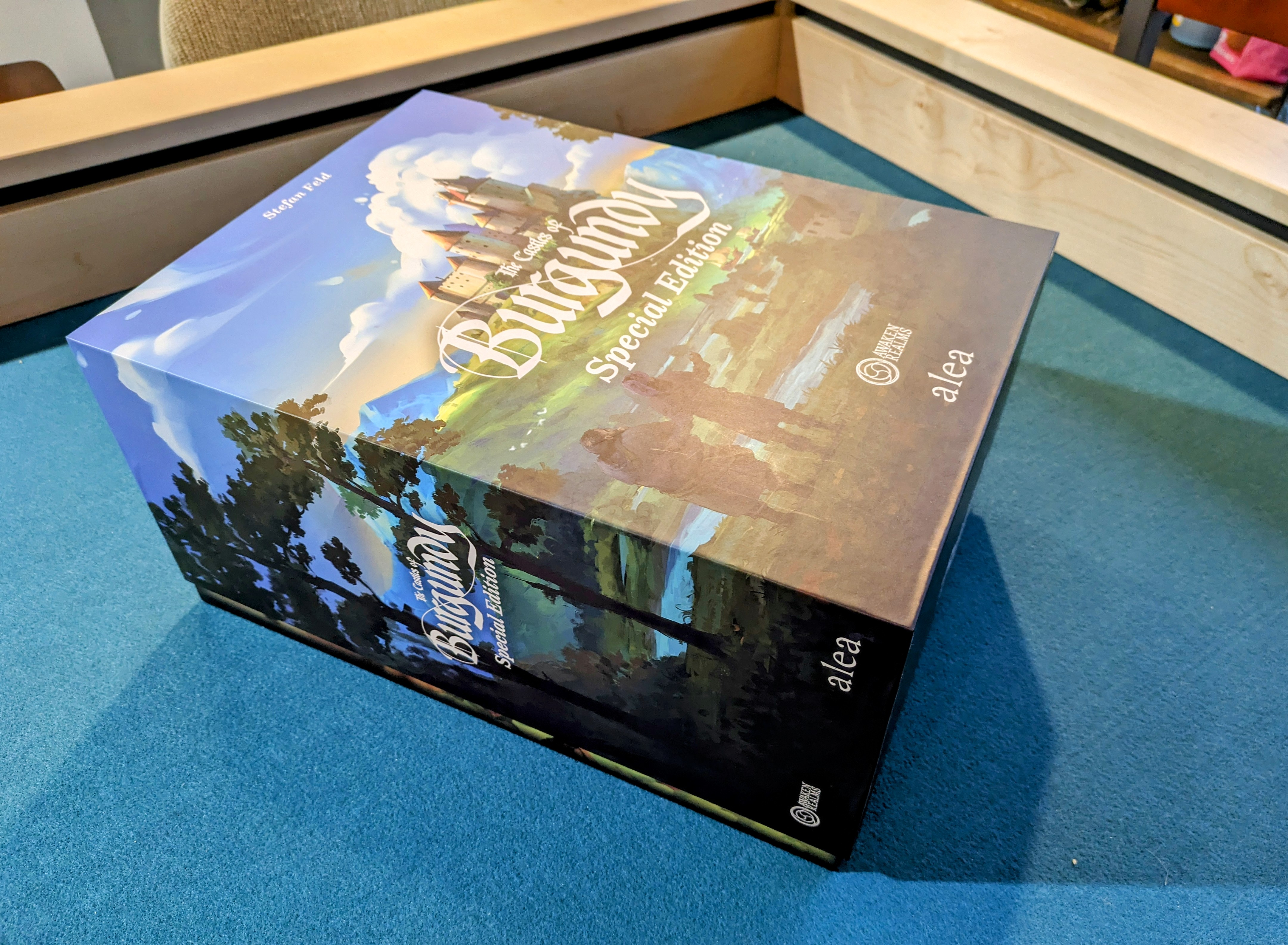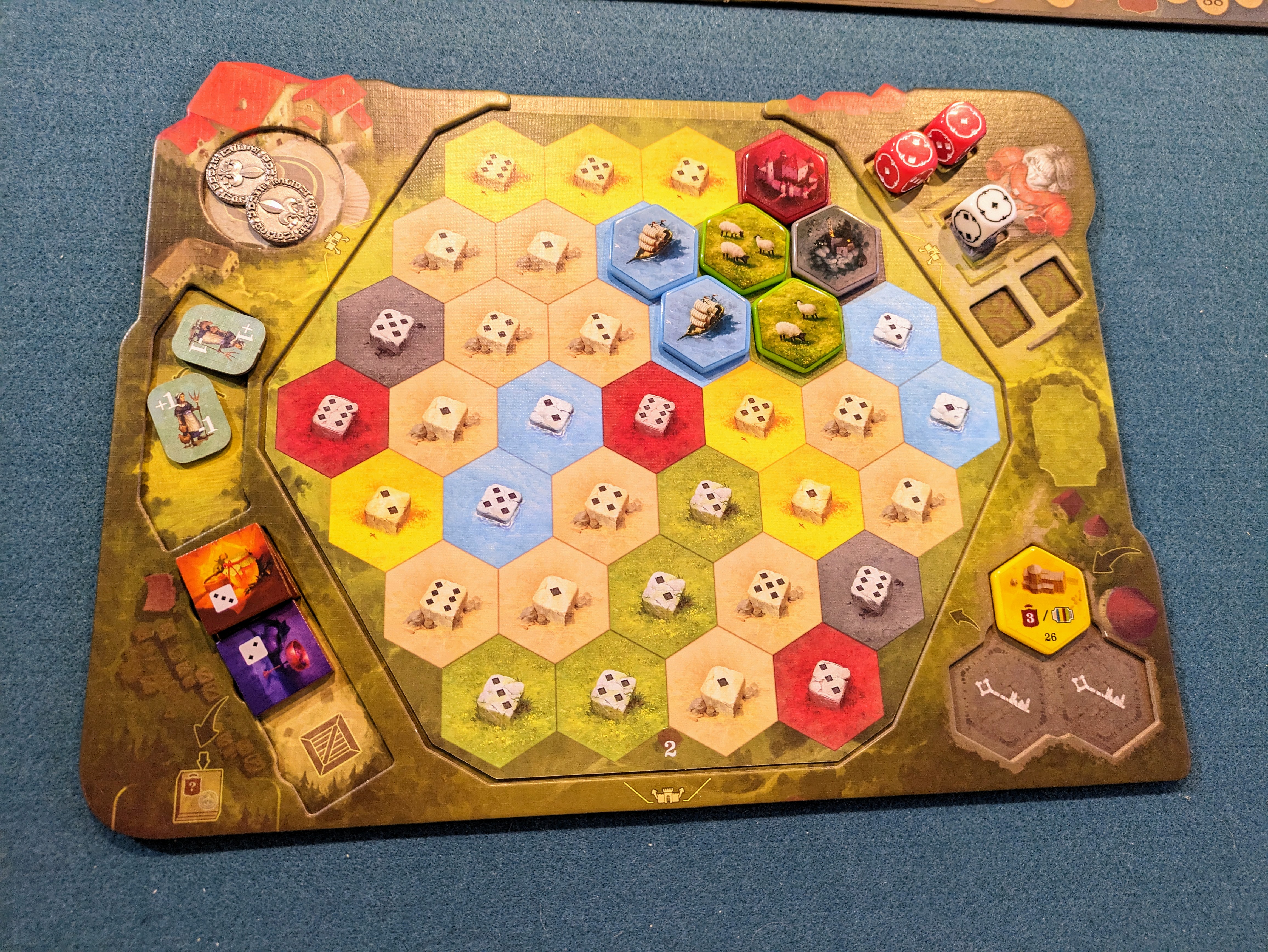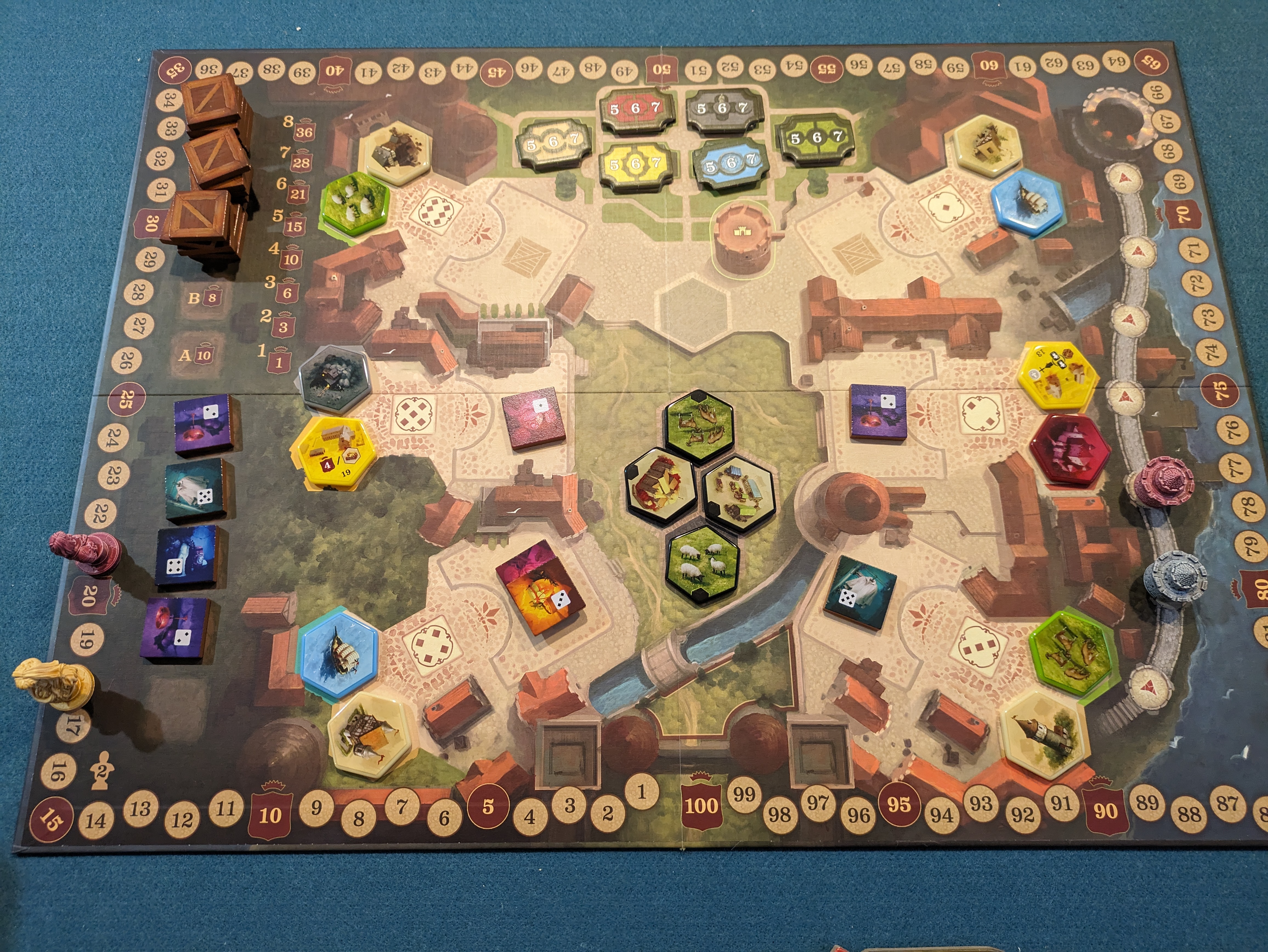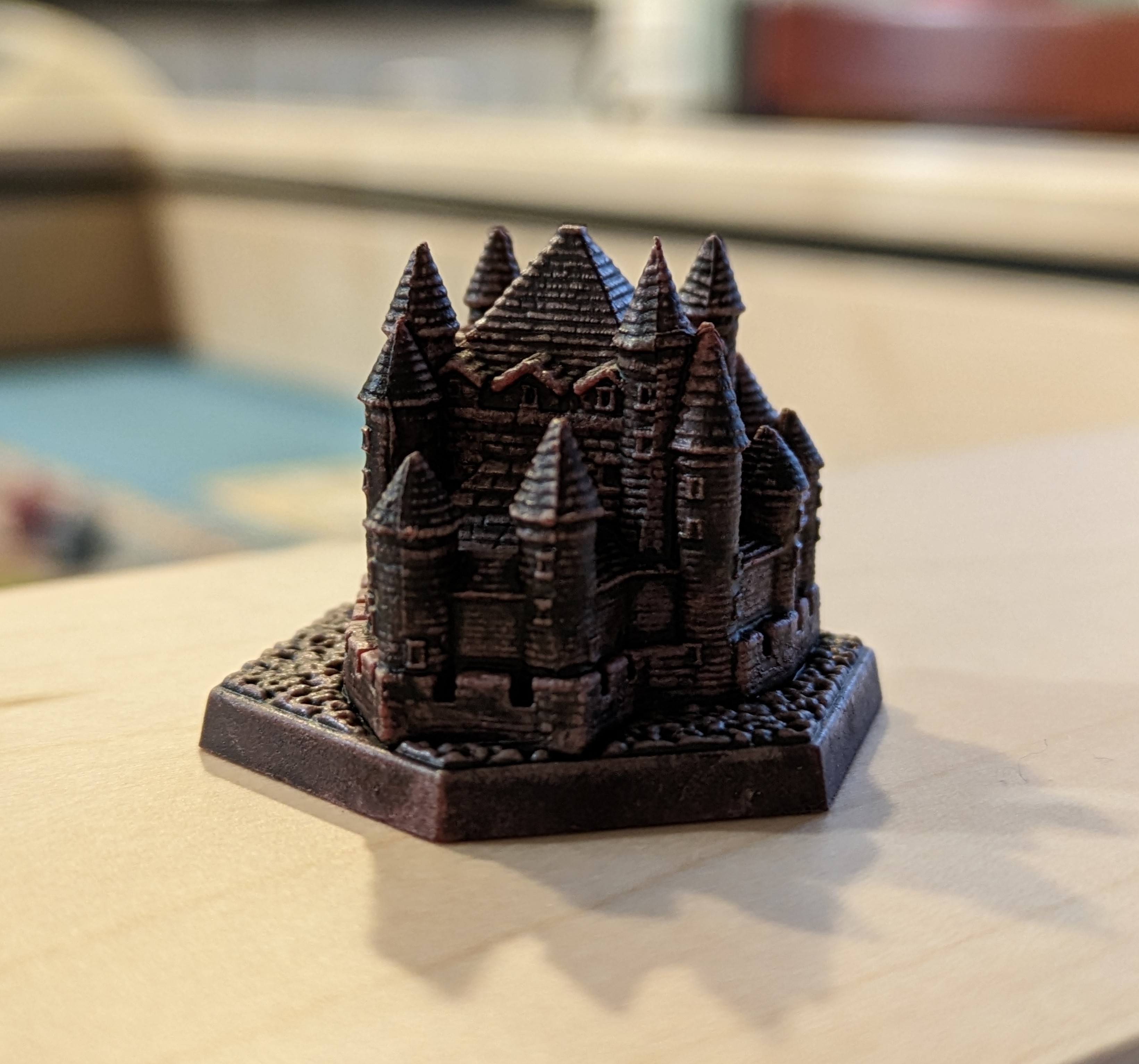By Brad Hammond

Alea & Awaken Realms release a Special Edition of Stefan Feld’s masterpiece worthy of Dukes and Duchesses, full of eye candy and expansions. The once Gamefound exclusive has a slightly scaled down retail version, available now. (This review was based on the Royal Sundrop Pledge w/ acrylic hex tiles & neoprene playmat add-ons – Please be advised that some contents/components may be different in the retail version)
Castles of Burgundy SE Components
The redesigned center board is once again two-sided for on player count, but now much larger and printed on thick cardboard stock. New double-layer player boards have slots for tiles, coins, worker tiles and dice, and some printed notation for expansions. Notably, the player boards no longer have the player aid printed on, as the original version did, but superior double-sided player aids are provided which include details of monastery powers (more on that later). The other bits and bobs are all improved, as should be expected with a Special Edition, including the dice, player tokens, turn order tokens, coins, worker tiles, point tokens. The goods tiles are now much thicker, more resembling three-dimensional crates, have better color differentiation and slot satisfyingly into the aforementioned slotted player boards. The rulebook has been completely overhauled and lays out the different expansions in a clear and concise manner. Molded plastic inserts hold everything in their place, although many people have played around with different “reboxing” orientations to suit their preferences and avoid the dreaded “lid lift.” (Mine has lid lift, I don’t care and you probably shouldn’t either.)
The hexagonal tiles (to be henceforth called out as either hexes or tiles, without any consistency) are slightly larger than before and adorned with beautiful, all-new artwork. Cardboard versions now have printed rule excerpts on the backside of each hex, which is welcoming for newcomers and almost a necessity for some of the monastery powers. The acrylic tiles do not have rules printings on the back sides, but files have been made available to print your own in your preferred language or a quick trip to Etsy (as I did) can round out that shortcoming. Opaque cloth bags are provided for hexes which need to be randomized and many, many duchy sheets (the layouts for your player board) are included for play variation. Perhaps the biggest upgrade to the hexes are the color changes. The original 2011 version featured yellow-green monasteries, green-green livestock hexes, and dark green castles. Now the monasteries are yellow, the livestock are the only green tiles, and the castles are…wait for it…burgundy.
Side note: The original German version was, of course, Die Burgen von Burgund, for “castles” in the French region Burgogne, which the English call Burgundy. So while it seems obvious to English speakers to make the castle hexes the dark red hue of burgundy, the wordplay of the original title likely had nothing to do with color.
Gameplay
Castles of Burgundy (CoB) is a Euro-style game where players attempt to build out their individual duchies with hexagonal tiles of various types from central public depots to score the most victory points. The game is broken up into 5 phases or seasons, denoted A through E, and in each season there are 5 turns, in which all players will take at least two actions each.
Castles of Burgundy Setup and Rules
Each player will start with a blank duchy board, which can be identical but are usually different from each other, where matching tile types must be placed. They also get their colored player tokens for scoring, turn-order trackers and two six-sided dice, a starting castle, a coin (silverlings, officially but we’re going to call them coins here), three random goods tiles, and worker tokens based on turn order. The duchies are broken into contiguous colored areas, relating to each type of hex tile, and each individual hex has a number value 1-6 corresponding to the D6 values. Tan areas are known as “towns,” for the buildings hexes – really the meat of the game, and there are green “fields” for livestock tiles, yellow areas for monasteries, blue spaces for ships, grey locations for mines, and burgundy hexes for the titular castles.

Using each player’s two dice, simultaneously rolled by all once per turn, the corresponding values will be used to obtain tiles from the numbered depots, place previously acquired tiles from the player’s limited “key storage” areas onto the duchy board, or ship goods of the same number from a player’s limited “storeroom” for a coin and 2 VPs per good shipped. A die result can always be traded in for two worker tokens, which are used to alter a die result +/-1, allowing for 6s to be turned into 1s and vice versa. Placement rules are that a tile must be placed next to an existing tile on the player’s duchy board, so the start castle placement determines where you’ll be building out from.
At the start of each phase, the central board numbered depots are loaded with tiles of the prescribed types and scale for player count. Ships, mines and castles are always populated, the latter two in less abundance. Livestock, buildings & monasteries are drawn randomly from their corresponding bags. The “black market” is also populated randomly, featuring hexes of any type (buildings, livestock, monasteries, mines, ships, castles).

Developing Your Kingdom
The main focus is to build out your duchy, as the placement of hexes is what typically grants you additional actions and/or points. Completing a full group of one colored area on your duchy will earn victory points based on the overall size of the area and there is a bonus depending on what season you are in when completed. So completing a town of 3 buildings in phase A will net you just 6 points for the relatively small area but with a bonus of +10 for finishing it so early in the game. Progressively, this bonus is less with each passing season, going down to just +2 in the last phase. Larger towns will not get completed early on, but a town of 7 will score you a whopping 28 VPs. As the tiles are replaced only at the beginning of each season, and quasi-randomly at that, the hexes you want or need to grab won’t stay available for long, so your decisions tend to become tougher as the phases and game progress. Completing all of one color/hex type (eg all grey mine spaces) on your duchy will snag you an end-game scoring tile with points that scale for player count, in addition to the seasonal bonus and scoring for the area.
What makes Castles of Burgundy special though, is that almost every tile DOES something when you place it onto your duchy. Livestock scores you points for the number of animals on the tile and you re-score a number of the same animal within the same field. If you’ve got a field with a 4-cow tile, which netted you 4 sweet VPs earlier, and place a 3-cow tile in the same area of green, well that new tile scores you 7 VPs. Grab another cow tile or the “magical” geese tile (see expansions) and score even more next time you place it in that field.
Mines will generate coins each season but are scarcely available. Ships will let you move forward on the turn order track and collect goods from a numbered depot of your choice, which are routinely filled each turn by an extra white die rolled by the first player. Monasteries will give you a unique player power or provide additional scoring opportunities to help guide your development.
The tan building tiles all do something different when placed. A bank will get you 2 coins, boarding house will provide for 4 worker tokens, carpenter’s workshop will let you grab another building tile from one of the numbered depots, while a church lets you grab a castle, mine or monastery, and so forth. Other building types will let you place tiles from your storage, acquire ships or livestock, or ship goods. One of the delicious friction points for buildings though, is that towns (contiguous tan areas) can only feature one building of each type.

Oh look, you just need one more building to complete that town, so you go to grab a tower, a building type that scores you immediate 4 VPs, but realize that you already have a tower in that town! What was surely to be a bevy of points for finishing that town may not get completed in this phase after all, lowering the associated season bonus. Of course, there exists a monastery tile that gives you the power to have repeat building types in the same town, but will it come out soon, if at all?
So what do the castles actually do? Why, anything and everything. They can be any dice result you wish, allowing you to acquire a tile or place a tile, sell goods from your storehouse, or just grab a couple more workers (don’t do that last one though – that’s not very efficient and you’re better than that). Castles are limited in availability and because they are powerful, they will go early in the seasons.
At the end of the fifth season, players add to their score tracker for any monastery powers that contribute to scoring and VPs from end-game scoring tokens to determine the winning player with the highest total. And if you didn’t win, as is common for me, just look at your beautiful duchy. You built that, and no one can take that away from you – congratulations!
Castles of Burgundy Special Edition Expansions
The Special Edition comes with the brand new Vineyards expansion, with triple-layered vineyard player boards that nest cozily to the normal player boards. Vineyard tiles are double hexes, which will clog up your three available slots, and there is a standee for the vineyards tiles market. It’s completely optional, but adds a new dimension to the game, that modern Euro players will appreciate. If you’re new to CoB, probably skip it for a few games. If you do introduce it, however, don’t sleep on grabbing those tiles. It’s very difficult to win if you don’t pay attention to the vineyards at all, especially in the new solo “Chateauma” mode.
Every expansion to date, that I’m aware of, is included. Some of which are just extra/different duchy boards, a welcome but not too exciting addition. A few quick thoughts on the expansions:
- Expansion 2: The four extra tiles (geese! crane! two good monastery powers! Did I mention geese?!?) is a must – plus it’s easy to forget to remove them at cleanup)
- Expansion 5: White Castles are now in every game of mine, but remember to scale them according to player count. Spices up the white die.
- Expansion 6: Inns are very good, but with the White Castles (Expansion 4) and the Crane from Expansion 2, it makes those big building towns easier to fill out. I always like the risk/reward of going for a 7-8 size building town, not sure if enough different types of buildings will be drawn/available. These expansions effectively gives you 3 new building types that reduces that risk greatly.
- Expansion 8: Trade routes make selling goods more interesting, which make sense to draw more focus to an aspect of the game that may seem innocuous but can rack up good points and generate coins for black market purchases.
- New Shields Expansion is neat, especially for those weirdos who tend to throw doubles often (and doubles can be painful near the ends of the phases),
- New Solo “Chateauma” mode is very nice. Simple, without the vineyards, but more challenging with.
I’d caution against using too many expansions at once, as you’re going to lose some of those crunchier decisions by giving players too many options with their dice rolls.
Upgrades, people
Acrylic tiles
Admittedly, the acrylic tiles are not environmentally friendly and we all could do with less plastic. But they feel so nice in the hand and on the board and clink in the bag satisfyingly. I don’t think you need the acrylic hexes, but it definitely elevates the experience. And if you’re spending $179+ for a version of this Special Edition, what’s another $30-$40 to make it extra special? Those tiles should be available for a while, but you may have to ship internationally. As stated earlier, getting the rules stickers for the back is recommended for introducing the game to new players. There are also acrylic worker & scoring tokens, available separately from the tiles, but I don’t think they’re as necessary.
Castle figurines and terrain tiles
The four different castle molds are all gorgeous and the “sundrop” paint looks great. The terrain tiles (which I don’t have) also look terrific. BUT NO ONE NEEDS THIS. You’re still playing with the tiles and then swapping out for the 3D miniatures. As with anything that starts in crowdfunding, though, it seems miniatures must be part of the campaign. This is just pure style over substance and actually slows down the game and obscures player boards from others trying to maximize their strategies.

Neoprene Mat
Yeah, I don’t know why I get some of these things. I actually prefer the chunky cardboard central board but the mat is fine. The colors are just a bit more washed out and good luck digging this out of your rack/closet of game mats because it doesn’t really fit in the box.
Final Verdict
 Castles of Burgundy is an all-timer. I just love the bit of randomness from the dice, which can be mitigated, and the slightly different player boards give you just enough direction in building out your duchy. You’re competing with the other players, but not in a mean way (unless you come between Jason and his beloved goats). And as with many games where you’re building a tableau or engine or city, there is a satisfaction with building YOUR duchy. It’s great and scales with 2, 3 or 4 players, even the solo is a good time. I love this game and don’t think I or anyone invested in this hobby could have a bad time playing it.
Castles of Burgundy is an all-timer. I just love the bit of randomness from the dice, which can be mitigated, and the slightly different player boards give you just enough direction in building out your duchy. You’re competing with the other players, but not in a mean way (unless you come between Jason and his beloved goats). And as with many games where you’re building a tableau or engine or city, there is a satisfaction with building YOUR duchy. It’s great and scales with 2, 3 or 4 players, even the solo is a good time. I love this game and don’t think I or anyone invested in this hobby could have a bad time playing it.
You should have a copy in your collection. Do you NEED this Special Edition? Probably not. The game that worked in 2011(!) still works today and you should be able to pick up an old copy relatively cheaply and easily. But if you want to celebrate a beloved game and have the means to splurge on the definitive version, this Special Edition is worth it.







Leave a Comment